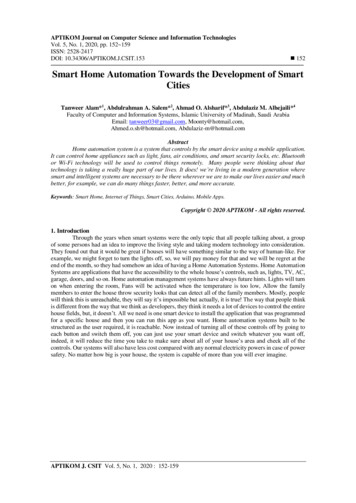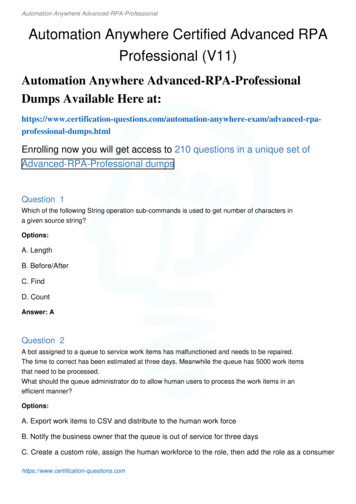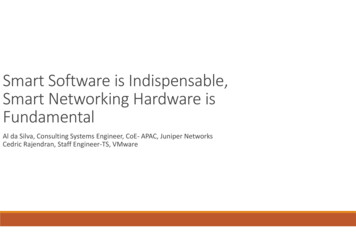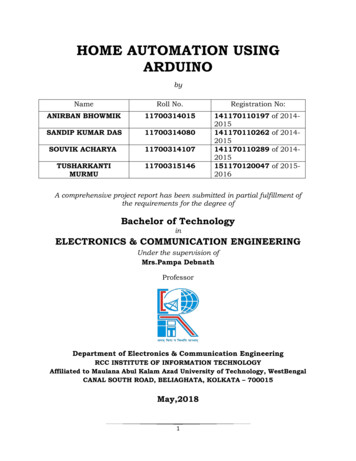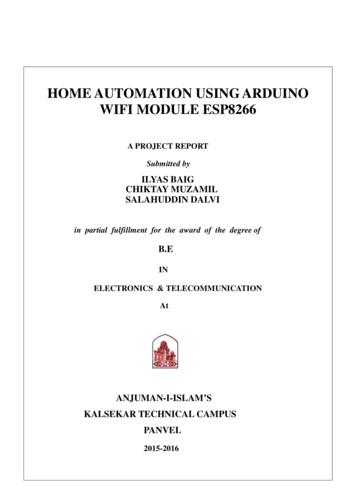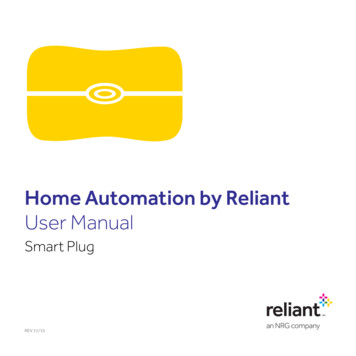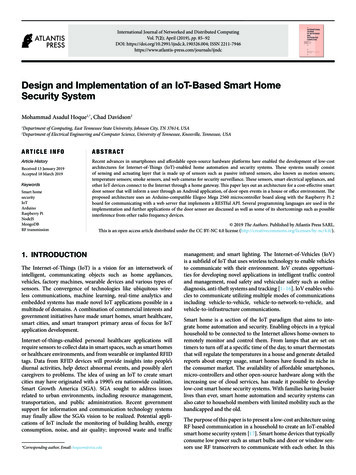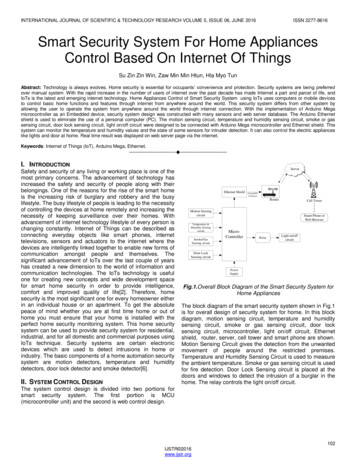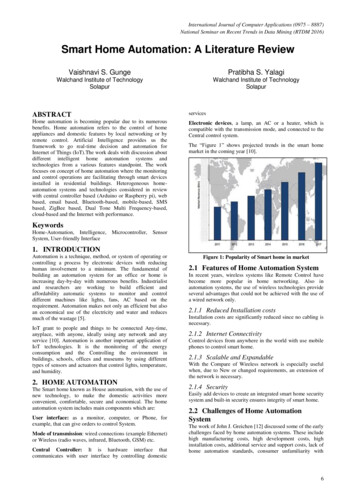
Transcription
International Journal of Computer Applications (0975 – 8887)National Seminar on Recent Trends in Data Mining (RTDM 2016)Smart Home Automation: A Literature ReviewVaishnavi S. GungePratibha S. YalagiWalchand Institute of TechnologySolapurWalchand Institute of TechnologySolapurABSTRACTservicesHome automation is becoming popular due to its numerousbenefits. Home automation refers to the control of homeappliances and domestic features by local networking or byremote control. Artificial Intelligence provides us theframework to go real-time decision and automation forInternet of Things (IoT).The work deals with discussion aboutdifferent intelligent home automation systems andtechnologies from a various features standpoint. The workfocuses on concept of home automation where the monitoringand control operations are facilitating through smart devicesinstalled in residential buildings. Heterogeneous homeautomation systems and technologies considered in reviewwith central controller based (Arduino or Raspberry pi), webbased, email based, Bluetooth-based, mobile-based, SMSbased, ZigBee based, Dual Tone Multi Frequency-based,cloud-based and the Internet with performance.Electronic devices, a lamp, an AC or a heater, which iscompatible with the transmission mode, and connected to theCentral control system.The “Figure 1” shows projected trends in the smart homemarket in the coming year [10].KeywordsHome-Automation, Intelligence,System, User-friendly InterfaceMicrocontroller,Sensor1. INTRODUCTIONAutomation is a technique, method, or system of operating orcontrolling a process by electronic devices with reducinghuman involvement to a minimum. The fundamental ofbuilding an automation system for an office or home isincreasing day-by-day with numerous benefits. Industrialistand researchers are working to build efficient andaffordability automatic systems to monitor and controldifferent machines like lights, fans, AC based on therequirement. Automation makes not only an efficient but alsoan economical use of the electricity and water and reducesmuch of the wastage [5].IoT grant to people and things to be connected Any-time,anyplace, with anyone, ideally using any network and anyservice [10]. Automation is another important application ofIoT technologies. It is the monitoring of the energyconsumption and the Controlling the environment inbuildings, schools, offices and museums by using differenttypes of sensors and actuators that control lights, temperature,and humidity.2. HOME AUTOMATIONThe Smart home known as House automation, with the use ofnew technology, to make the domestic activities moreconvenient, comfortable, secure and economical. The homeautomation system includes main components which are:User interface: as a monitor, computer, or Phone, forexample, that can give orders to control System.Mode of transmission: wired connections (example Ethernet)or Wireless (radio waves, infrared, Bluetooth, GSM) etc.Central Controller: It is hardware interface thatcommunicates with user interface by controlling domesticFigure 1: Popularity of Smart home in market2.1 Features of Home Automation SystemIn recent years, wireless systems like Remote Control havebecome more popular in home networking. Also inautomation systems, the use of wireless technologies provideseveral advantages that could not be achieved with the use ofa wired network only.2.1.1 Reduced Installation costsInstallation costs are significantly reduced since no cabling isnecessary.2.1.2 Internet ConnectivityControl devices from anywhere in the world with use mobilephones to control smart home.2.1.3 Scalable and ExpandableWith the Compare of Wireless network is especially usefulwhen, due to New or changed requirements, an extension ofthe network is necessary.2.1.4 SecurityEasily add devices to create an integrated smart home securitysystem and built-in security ensures integrity of smart home.2.2 Challenges of Home AutomationSystemThe work of John J. Greichen [12] discussed some of the earlychallenges faced by home automation systems. These includehigh manufacturing costs, high development costs, highinstallation costs, additional service and support costs, lack ofhome automation standards, consumer unfamiliarity with6
International Journal of Computer Applications (0975 – 8887)National Seminar on Recent Trends in Data Mining (RTDM 2016)technology, and complex user interfaces. With theadvancement of time, rapid development in technology andprocessing power which leads to a considerable reduction indevice cost and size. All of these factors have contributed tothe popularity of electronic devices today, so people are nolonger confused or unsure about the use of the computer,mobiles, or tablets. Moreover, a lot of home automationprotocols, communication and interface standards.3. LITERATURE REVIEWIn this section, discussed different Home Automation Systemwith their technology with features, benefit and limitationsthey have. “The Figure 2” shows Basic Architecture ofRemote Home Automation.Device,Things lingUserInterfaceSystemVia Ethernet,Bluetooth, GSM, Wi-FiFigure 2: Basic Block Diagram of Home AutomationThe Home automation system that uses Wi-Fi technology [1].System consists of three main components; web server, whichpresents system core that controls, and monitors users’ homeand hardware interface module(Arduino PCB (ready-made),Wi-Fi shield PCB, 3 input alarms PCB, and 3 output actuatorsPCB.), which provides appropriate interface to sensors andactuator of home automation system. The System is betterfrom the scalability and flexibility point of view than thecommercially available home automation systems. The Usermay use the same technology to login to the server web basedapplication. .If server is connected to the internet, so remoteusers can access server web based application through theinternet using compatible web browser.The application has been developed based on the androidsystem [2]. An interface card has been developed to assurecommunication between the remote user, server, raspberry picard and the home Appliances. The application has beeninstalled on an android Smartphone, a web server, and araspberry pi card to control the shutter of windows. Androidapplication on a smartphone issue command to raspberry picard. An interface card has been realized to update signalsbetween the actuator sensors and the raspberry pi card.Cloud-based home appliance monitoring and controllingSystem. Design and implement a home gateway to collectmetadata from home appliances and send to the cloud-baseddata server to store on HDFS (Hadoop Distributed FileSystem), process them using MapReduce and use to provide amonitoring function to Remote user [3].It has been implemented with Raspberry Pi through readingthe subject of E-mail and the algorithm. Raspberry Pi provesto be a powerful, economic and efficient platform forimplementing the smart home automation [4].Raspberry pibased home automation is better than other home automationmethods is several ways. For example, in home automationthrough DTMF (dual tone multi-frequency) [11], the call tariffis a huge disadvantage, which is not the case in their proposedmethod. Also, in Web server based home automation, thedesign of web server and the memory space required isejected by this method, because it simply uses the alreadyexisting web server service provided by G-mail. LEDs wereused to indicate the switching action. System is interactive,efficient and flexible.Shih-Pang Tseng et al. [5] proposed Smart House Monitor &Manager (SHMM), based on the ZigBee, all sensors andactuators are connected by a ZigBee wireless network. Theydesigned a simple smart socket, which can remote control viaZigBee. PC host is used as a data collector and the motionsensing, all sensing data are transferred to the VM in thecloud. The user can use the PC or Android phone to monitoror control through the Internet to power-saving of the house.Arduino microcontroller to receive user commands to executethrough an Ethernet shield. Our house network used togetherboth wireless ZigBee and wired X10 technologies [6]. Thissystem followed smart task scheduling with a heuristic for theResource-constrained-scheduling problem (RCPSP). Themobile device can be either wired to the central controllerthrough USB cable or communicates with it wirelessly, withinthe scope of the home. Arduino contains the web serverapplication that communicates through the HTTP protocolwith Web-based Android application. The system is highlyflexible and scalable and expandable.The home network which monitors the appliances and sensorsand transmits data to the cloud-based data server whichmanages the information and provides services for users bytransmitting data and receiving user commands from mobileapplication [7]. The proposed system has good modularity andconfigurability characteristics with very low powerconsumption in cost efficient way.Application developed using the Android platform controlledand monitored from a remote location using the smart homeapp and an Arduino Ethernet based micro web-server [8]. Thesensors and actuators/relays are directly interfaced to the maincontroller. Proposed design offers are the control of energymanagement systems such as lightings, heating, airconditioning, security, fire detection and intrusion detectionwith siren and email notifications.Embedded system Raspberry Pi to serve as a communicationgateway between mobile devices and Konnex-Bus (KNX)home automation systems [9]. Store the information of allactors and sensors within a Smart Home, instead of usingseparate profiles. Ensures energy-consumption could bereduced, compared to a standard desktop computer.Dual tone multi frequency (DTMF) used in telephone lines[13]. There are three components in the system DTMFreceiver and ring detector, IO interface unit, PC. The PCdetects the ringing of the line and then authenticates the userand use the keypad tones to control the devices as required.An example of stepper motor control is taken up. This systemhas the advantage of being secure and allowing internationalstandardization. This is because the DTMF tones are the sameall over the world. But it suffers from the drawback that thenumber of appliances is limited by the number of keys in thekeypad.PIC16F887 microcontroller for home appliances controlswith GSM for control of the appliances. [14]. It has highavailability, coverage and security but the cost of SMS. ATcommands can be sent through the GSM network to controlsthe home devices. The system does not does not have any7
International Journal of Computer Applications (0975 – 8887)National Seminar on Recent Trends in Data Mining (RTDM 2016)state information related to the devices and expects the user tokeep track of it.Arduino board is the controller used to control the appliancesby using GSM technology. It uses certain peripheral driversand relays to achieve this interfacing. The application onsmartphone generates SMS messages based on the usercommands and sends it to the GSM modem attached to theArduino and control the home appliances [15]. The systemhas drawbacks of cost and reliability of SMS. An interfacecannot be customized based on devices.It has been designed Arduino board with Bluetooth boardwere developed for home automation [16]. Python program isused on the cell phone to provide the user interface. TheBluetooth board has I/O ports and relays are used forinterfacing with the devices which are to be controlled andmonitor. The Bluetooth is password protected to ensure thatthe system is secure from intruders. The Bluetooth has a rangeof 10 to 100.3.1 Compassion of SystemDiscussed Comparison of Different Home AutomationSystems by considering its Central Microcontroller,Communication interface, User interface, provided featuresand their benefits as shown in “Table 1”.3.2 Evolution of System3.2.1Raspberry PiIt is a credit-card-sized single microcontroller computer.Python as the main programming language. It is easy to learnand suitable for real world applications [4]. There are twomain types of pi first one is Model A has 25 6Mb RAM, oneUSB port and no network connection and Model B has 512Mb RAM, 2 USB ports and an Ethernet port. It has aBroadcom BCM2835 system on a chip which includes anARMl176JZF -S 700 MHz processor, Video Core IV GPU,and an SD card. The chip specifically provides HDMI andthere is no VGA support. Arduino can successfully work withRaspberry Pi Computers.3.2.2ArduinoIt is a microcontroller board, not fully computers. In this,written codes are simply executed without any obstacle. It isan 8 bit Atmel AVR Microcontroller which comprises of 32Kand 512K of onboard flash memory, 2K of RAM, runs at 884MHz clock speeds with voltages of 2.7V-12V.programmingis done using C and carries no operating system. The code iswritten in the computer and then sent through USB cable forexecution. Its construction simply covers digital input-outputpins that are between 9-54 AND 6-12 analog input pins. Itspower consumption is less than 0.5 watt.4. CONCLUSIONSBased on surveyed study the comparison of home automationsystems are presented. Microcontroller, user interface, acommunication interface and their performance factor arecompared. There are a number of do-it-yourself (DIY)platforms available that allow to create Home Automationsystem quickly and easily with low cost and high performancee.g. Raspberry pi, Arduino, other microcontrollers, etc. In thisreview explained different home automation system e.g. Webbased, email based, Bluetooth-based, mobile-based, SMSbased, ZigBee-based, Dual Tone Multi Frequency-based,cloud-based and Internet based. In future home automationwill more smart and fast. It would be extended to the largescale environment such as colleges, offices and factories etc.Table 1. lerUserInterfaceApplicationsBenefits1.Wi-Fi based usingArduinoMicrocontrollerWireless L
the scope of the home. Arduino contains the web server application that communicates through the HTTP protocol with Web-based Android application. The system is highly flexible and scalable and expandable. The home network which monitors the appliances and sensors and transmits data to the cloud-based data server whichFile Size: 521KBPage Count: 5
